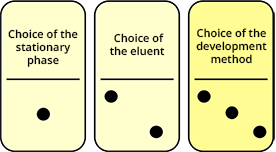Choice of the development method
- In "natural" light: if the compounds are colored and therefore absorb in the visible range.
- Using a UV lamp: if the compounds, which are non-volatile, absorb UV.
Usually a fluorescent agent is incorporated into the stationary phase; the plate then appears fluorescent green under the lamp.
If the compound deposited on the plate absorbs UV radiation, it reduces fluorescence. The compounds are then revealed in the form of dark spots because they cause local extinction of the fluorescence. - Using a "universal" reagent: the most common are diiodine, potassium permanganate or phosphomolybdic acid.
This method is used in particular when the eluted compounds do not absorb in the UV-visible region and are therefore not directly visible. - With the aid of a specific reagent: many specific developers of the presence of chemical functions exist (2,4-DNPH for carbonyls, Draggendorf reagent for alkaloids, ninhydrin for amino acids, etc.)





